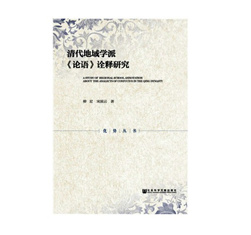
. > WHAT'S NEW > BOOKS
Regionally exploring Qing annotations about The Analects
Author : ZHU DECI Source : Chinese Social Sciences Today 2020-01-20

A Study of Regional School Annotation of the Analects of Confucius in the Qing Dynasty
In A Study of Regional School Annotation of the Analects of Confucius in the Qing Dynasty, Liu Hong and Song Zhanyun, a professor and an associate professor from the College of Humanities at Yangzhou University, explore the annotations of various schools in the Qing Dynasty (1644–1911) on The Analects of Confucius from regional perspectives.
In the book, 58 Qing annotators of The Analects are classified into seven groups, including the Wu School, the Wan School, the Yangzhou School, the Changzhou School, the Eastern Zhejiang School, the Lingnan School and the Huxiang School. The seven schools were largely distributed along the Grand Canal and the Xiang River and in Shandong Province.
From a temporal perspective, the Wu School was born earlier than the Wan School. The Wu School dates back to the Confucian Ding Hongdu (1602–81) in Suzhou in the late Ming and early Qing era. He was the first to conduct systematic research into Han Confucianism, influencing the study in this field in Suzhou, with Hui Zhouti as an outstanding representative. The Wan School can be traced back to Xin’an Neo-Confucianism, which upheld the thought of Zhu Xi (1130–1200) as its main theoretical foundation. Zhu Xi’s ancestral home was located in Xin’an, also known by Huizhou. The commitment of Xin’an Neo-Confucianism to the pursuit of truth and facts directly nourished the textual research of the Wan School and cultivated the profound rationalist tradition of Huizhou culture.
Academic circles have harbored some stereotypes for a long time. For example, that the Changzhou School paid attention to the New Text Confucianism of the Han Dynasty (202 BCE–220 CE), advocated the idea of the “great unification” and “three epochs” of the Gongyang School, emphasized the application of Confucian classics to real society and politics, and focused on the “deep meaning” behind the highly refined words of the Confucian classics. According to this standard, the Yangzhou Confucian Liu Gongmian (1824–83) was traditionally considered to be included in the Changzhou School. However, although the classification demonstrates that his features of research were typical of the Changzhou School, this view restricts us from fully exploring his thought in a divergent and innovative way. This limitation could be broken down from the regional perspective. Actually, Liu Gongmian had no friends or teachers of the Changzhou School, and his learning was influenced by the Yangzhou School to a certain extent, which made his research methods mainly focus on compilation and textual criticism. He tried to seek truth from facts without adhering to the thought of a certain school in order to attain thorough understanding, displaying the typical features of the Yangzhou School.
Zhu Deci is a professor from the College of Humanities at Yangzhou University.
Ye Shengtao made Chinese fairy tales from a wilderness
Ye Shengtao (1894–1988) created the first collection of fairy tales in the history of Chinese children’s literature...
-
How northern ethnicities integrated into Chinese nation
2023-09-18
-
Mogao caves
2023-09-12
-
Mogao Grottoes as ‘a place of pilgrimage’
2023-09-12
-
Time-honored architectural traditions in China
2023-08-29
-
Disentangling the civilizational evolution of China
2023-08-28
-
AI ethics in science fiction
2023-08-23













 2011-2013 by www.cssn.cn. All Rights Reserved
2011-2013 by www.cssn.cn. All Rights Reserved